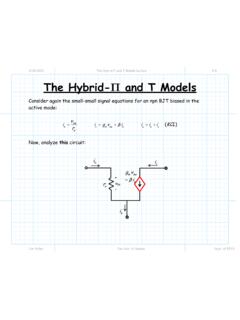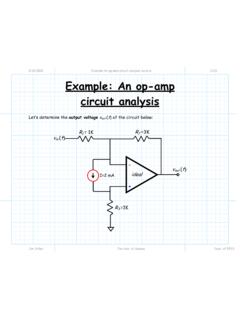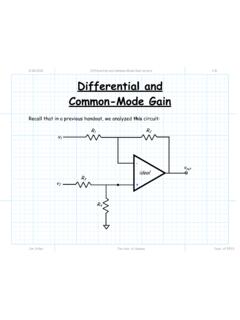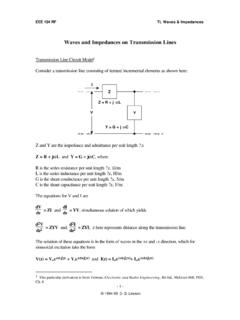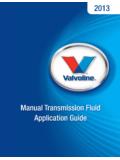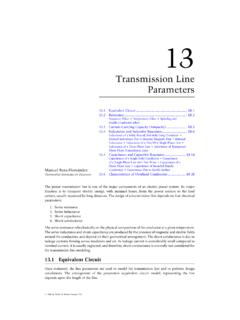Transcription of Transmission Line Input Impedance - ITTC
1 1/26/2005 Transmission line Input 1/9 Jim Stiles The Univ. of Kansas Dept. of EECS Transmission line Input Impedance Consider a lossless line , length A, terminated with a load ZL. Let s determine the Input Impedance of this line ! Q: Just what do you mean by Input Impedance ? A: The Input Impedance is simply the line Impedance seen at the beginning (z= A) of the Transmission line , : ()()()inVzZZzIz= == == AAA Note Zin equal to neither the load Impedance ZL nor the characteristic Impedance Z0 ! 0 and ininLZZZZ I(z) 0,Z + V (z) - + VL - A ZL IL z= A0z=1/26/2005 Transmission line Input 2/9 Jim Stiles The Univ.
2 Of Kansas Dept. of EECS To determine exactly what Zin is, we first must determine the voltage and current at the beginning of the Transmission line (z= A). 000jjLjjLV(z) V eeVI(z)eeZAAAAAA + +++ = =+ = = Therefore: ()()0jjLinjjLVzeeZZIzee+ + = + == = AAAAAA We can explicitly write inZ in terms of load ZL using the previously determined relationship: 00 LLLZZZZ =+ Combining these two expressions, we get: ()()()()()()()()00000000jjLLinjjLLjjjjLj jjjLZZeZZeZZZZeZZeZeeZeeZZeeZee + + + + + + ++ =+ ++ = + AAAAAA AAAA AA Now, recall Euler s equations: cossincossinjjejej + =+= AAAAAA 1/26/2005 Transmission line Input 3/9 Jim Stiles The Univ.
3 Of Kansas Dept. of EECS Using Euler s relationships, we can likewise write the Input Impedance without the complex exponentials: 000000cossincossintantanLinLLLZjZZZZjZZj ZZZjZ += + += + AAAAAA Note that depending on the values of 0, and Z A, the Input Impedance can be radically different from the load Impedance ZL ! Special Cases Now let s look at the Zin for some important load impedances and line lengths. You should commit these results to memory! 1. 2 =A If the length of the Transmission line is exactly one-half wavelength (2 =A), we find that: 22 ==A meaning that: cos cos 1 and sin sin 0 == ==AA 1/26/2005 Transmission line Input 4/9 Jim Stiles The Univ.
4 Of Kansas Dept. of EECS and therefore: 00000cossincossin(1)(0)(1)(0)LinLLLLLZjZ ZZZjZZjZZZjZZ += + += + =AAAA In other words, if the Transmission line is precisely one-half wavelength long, the Input Impedance is equal to the load Impedance , regardless of Z0 or . 2. 4 =A If the length of the Transmission line is exactly one-quarter wavelength (4 =A), we find that: 242 ==A meaning that: cos cos 2 0 and sin sin 2 1 ====AA 0,Z 2 =A ZL inLZZ= 1/26/2005 Transmission line Input 5/9 Jim Stiles The Univ. of Kansas Dept. of EECS and therefore: ()00000020cossincossin(0)(1)(0)(1)LinLLL LZjZZZZjZZjZZZjZZZ += + += + =AAAA In other words, if the Transmission line is precisely one-quarter wavelength long, the Input Impedance is inversely proportional to the load Impedance .
5 Think about what this means! Say the load Impedance is a short circuit, such that 0LZ=. The Input Impedance at beginning of the 4 Transmission line is therefore: ()()22000inLZZZZ=== inZ= ! This is an open circuit! The quarter-wave Transmission line transforms a short-circuit into an open-circuit and vice versa! 0,Z 4 =A ZL=0 inZ= 1/26/2005 Transmission line Input 6/9 Jim Stiles The Univ. of Kansas Dept. of EECS 3. 0 LZZ= If the load is numerically equal to the characteristic Impedance of the Transmission line (a real value), we find that the Input Impedance becomes: 000000000cossincossincossincossinLinLZjZ ZZZjZZjZZZjZZ += + += + =AAAAAAAA In other words, if the load Impedance is equal to the Transmission line characteristic Impedance , the Input Impedance will be likewise be equal to Z0 regardless of the Transmission line length A.
6 4. LLZjX= If the load is purely reactive ( , the resistive component is zero), the Input Impedance is: 0,Z A ZL=Z0 0inZZ= 1/26/2005 Transmission line Input 7/9 Jim Stiles The Univ. of Kansas Dept. of EECS 0000020000cossincossincossincossincossin cossinLinLLLLLZjZZZZjZjXjZZZjXXZjZZX += + += + += AAAAAAAAAAAA In other words, if the load is purely reactive, then the Input Impedance will likewise be purely reactive, regardless of the line length A. Note that the opposite is not true: even if the load is purely resistive (ZL = R), the Input Impedance will be complex (both resistive and reactive components).
7 Q: Why is this? A: 0,Z A ZL=jXL ininZjX= 1/26/2005 Transmission line Input 8/9 Jim Stiles The Univ. of Kansas Dept. of EECS 5. A If the Transmission line is electrically small its length A is small with respect to signal wavelength --we find that: 220 == AAA and thus: cos cos 0 1 and sin sin 0 0 ====AA so that the Input Impedance is: 00000cossincossin(1)(0)(1)(0)LinLLLLLZjZ ZZZjZZjZZZjZZ += + += + =AAAA In other words, if the Transmission line length is much smaller than a wavelength, the Input Impedance inZ will always be equal to the load Impedance LZ. This is the assumption we used in all previous circuits courses ( , EECS 211, 212, 312, 412)!
8 In those courses, we assumed that the signal frequency is relatively low, such that the signal wavelength is very large ( A). 1/26/2005 Transmission line Input 9/9 Jim Stiles The Univ. of Kansas Dept. of EECS Note also for this case ( the electrically short Transmission line ), the voltage and current at each end of the Transmission line are approximately the same! ()(0) and I()(0) if VzVzz Iz = == =AAA If A , our wire behaves exactly as it did in EECS 211 !





